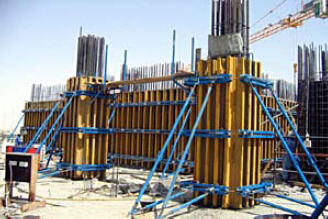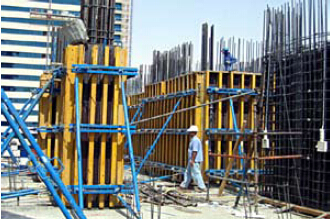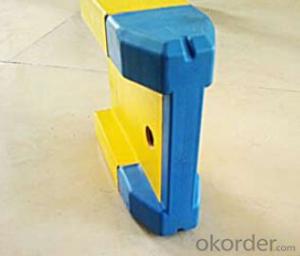Timber Beam Formwork for building Construction
- Loading Port:
- Tianjin
- Payment Terms:
- TT OR LC
- Min Order Qty:
- 50 m²
- Supply Capability:
- 1000 m²/month
OKorder Service Pledge
Quality Product, Order Online Tracking, Timely Delivery
OKorder Financial Service
Credit Rating, Credit Services, Credit Purchasing
You Might Also Like
Plywood --- make perfect concrete surface
WISA-Form Birch is a coated special plywood using in the formwork systems where high
requirements are set on the concrete surface and the times of reuses.
With CNBM timber beam & WISA plywood, the formwork is low weight but high load capacity, it is
widely used in construction.
Characteristics:
◆ Component with high standardization.
◆ Assembling in site, flexible application.
◆ Light weight, easy transportation and storage.



- Q:What are the considerations when designing steel formwork for dams?
- When designing steel formwork for dams, several key considerations need to be taken into account. Firstly, the structural stability and strength of the formwork is of utmost importance. Dams are large structures that exert significant forces, so the formwork needs to be able to withstand these forces without any deformation or failure. This requires careful analysis and design of the formwork system, including the selection of appropriate steel grades, sizes, and reinforcement. Another important consideration is the water pressure that the formwork will be subjected to during the construction and operation of the dam. The formwork needs to be watertight to prevent any leakage or seepage, as this can compromise the stability and integrity of the dam. Special attention should be given to the joints and connections of the formwork to ensure a tight and secure seal. Durability is another factor that needs to be considered when designing steel formwork for dams. Dams have a long design life, often spanning several decades, so the formwork needs to be able to withstand prolonged exposure to various environmental conditions, such as temperature changes, moisture, and chemical exposure. The formwork should be protected against corrosion, either through the use of corrosion-resistant steel or by applying protective coatings. The ease of assembly and disassembly is also an important consideration. Dams are complex structures that require a large number of formwork elements to be assembled and aligned accurately. The formwork system should be designed in a way that allows for easy and efficient installation and removal, minimizing the time and effort required for construction. Lastly, cost considerations play a significant role in the design of steel formwork for dams. The formwork system needs to be cost-effective and efficient, maximizing the use of materials and minimizing waste. The design should also take into account the availability and cost of steel, as well as the availability of skilled labor for fabrication and installation. Overall, the considerations when designing steel formwork for dams include structural stability, watertightness, durability, ease of assembly, and cost-effectiveness. By carefully addressing these factors, engineers can ensure the successful construction and long-term performance of the dam.
- Q:Can steel formwork be used for airport runway construction?
- Yes, steel formwork can be used for airport runway construction. Steel formwork is a versatile and durable option for creating concrete structures, including runways. It offers several advantages over other types of formwork, such as timber or aluminum. Firstly, steel formwork provides a high level of strength and stability, ensuring that the concrete pouring process is efficient and accurate. This is crucial for runway construction, as the surface needs to be even and strong enough to withstand heavy aircraft traffic. Secondly, steel formwork is reusable, making it cost-effective for large-scale projects like airport runways. Its durability allows it to be used multiple times, reducing the need for frequent replacements and saving both time and money. Additionally, steel formwork can be easily assembled and disassembled, making it convenient for construction sites with tight schedules or limited space. Its modular design allows for quick installation and adjustment, enabling efficient construction progress. Furthermore, steel formwork provides excellent resistance to various weather conditions, including extreme temperatures and moisture. This is vital for airport runways, as they are exposed to constant wear and tear from aircraft, as well as harsh weather conditions. In conclusion, steel formwork is a suitable choice for airport runway construction due to its strength, reusability, ease of use, and resistance to different weather conditions. Its ability to provide a stable and durable surface makes it an ideal option for creating runways capable of handling heavy aircraft traffic.
- Q:How does steel formwork handle different concrete surface cleaning methods?
- Steel formwork is highly durable and can withstand various concrete surface cleaning methods. It is resistant to most cleaning agents, such as water, detergents, and solvents, making it easy to clean. Steel formwork can be pressure washed, scrubbed, or even sandblasted to remove any hardened concrete residue or stains. Its smooth and non-porous surface allows for efficient cleaning, ensuring a clean and ready-to-use formwork for future concrete projects.
- Q:How does steel formwork handle concrete setting time and curing temperature?
- Steel formwork handles concrete setting time and curing temperature effectively. Steel is a good conductor of heat, allowing it to quickly absorb and dissipate heat from the concrete, which helps in controlling the concrete's setting time and curing temperature. The use of steel formwork also provides stability and strength, ensuring that the concrete maintains its shape and integrity during the setting and curing process. Additionally, steel formwork is durable and can withstand the high temperatures generated during curing, making it suitable for various construction projects.
- Q:Can steel formwork be used in earthquake-prone areas?
- Yes, steel formwork can be used in earthquake-prone areas. Steel formwork is known for its strength and durability, making it able to withstand the forces generated during an earthquake. Additionally, steel formwork offers flexibility in design and can be easily adjusted to meet the specific requirements of the structure, providing further stability in seismic zones.
- Q:Can steel formwork be used for tall structures?
- Yes, steel formwork can be used for tall structures. Steel is a strong and durable material that can withstand the weight and pressure of concrete. It offers the necessary stability and support required for constructing tall buildings and structures. Additionally, steel formwork is versatile, allowing for flexibility in design and construction.
- Q:How does steel formwork affect the overall cost of concrete construction?
- Steel formwork can increase the overall cost of concrete construction due to its higher initial investment compared to other formwork materials. However, it offers several advantages such as durability, reusability, and better quality finishes, which can result in cost savings in the long run by reducing the need for frequent replacements and rework. Additionally, steel formwork allows for faster construction and improved productivity, which can offset the initial cost by reducing labor expenses and project timelines.
- Q:What are the different types of coatings available for steel formwork?
- There are several types of coatings available for steel formwork, each with its own unique advantages and applications. 1. Paint coatings: These coatings provide a basic level of protection against corrosion and can be applied in various colors. They are typically inexpensive and easy to apply, making them a popular choice for general-purpose formwork. 2. Galvanized coatings: Galvanizing involves applying a layer of zinc to the steel surface, providing excellent corrosion resistance. It is particularly suitable for formwork used in harsh environments or where long-term durability is required. 3. Epoxy coatings: Epoxy coatings offer superior chemical resistance and durability compared to other types of coatings. They are commonly used in formwork that will come into contact with aggressive substances or in applications requiring a high level of hygiene, such as in the food industry. 4. Powder coatings: Powder coatings are applied as a dry powder and then baked to form a hard, durable finish. They offer excellent impact resistance and are available in a wide range of colors. Powder coatings are often used in formwork that will be exposed to significant wear and tear. 5. Polymer coatings: Polymer coatings, such as polyurethane or polyethylene, provide a protective layer over the steel surface. They offer good resistance to abrasion, impact, and chemicals, making them suitable for formwork used in demanding applications. 6. Thermal spray coatings: Thermal spray coatings involve the application of a molten material, such as zinc or aluminum, onto the steel surface. These coatings offer exceptional corrosion resistance and are commonly used in marine or offshore formwork. When selecting the appropriate coating for steel formwork, factors such as the intended use, environmental conditions, and budget should be considered. It is important to consult with coating specialists or manufacturers to determine the most suitable coating for specific applications.
- Q:Are there any specific safety guidelines for steel formwork construction?
- Yes, there are specific safety guidelines for steel formwork construction. These guidelines typically include recommendations for the proper handling and storage of steel formwork components, ensuring adequate bracing and support to prevent collapse, implementing fall protection measures for workers, and conducting regular inspections to identify and address any potential hazards. Additionally, adherence to general construction safety practices, such as providing personal protective equipment and maintaining a clean and organized work area, is also important in steel formwork construction.
- Q:What are the challenges of using steel formwork?
- One of the main challenges of using steel formwork is its high initial cost compared to other types of formwork. Steel formwork also requires skilled labor for its installation and removal, which can increase project expenses. Additionally, steel formwork is heavy and requires special transportation and handling equipment, making it less convenient and cost-effective for small-scale projects. Finally, steel formwork requires proper maintenance to prevent corrosion and ensure its longevity, adding to the overall cost and effort involved in its use.
1. Manufacturer Overview |
|
|---|---|
| Location | |
| Year Established | |
| Annual Output Value | |
| Main Markets | |
| Company Certifications | |
2. Manufacturer Certificates |
|
|---|---|
| a) Certification Name | |
| Range | |
| Reference | |
| Validity Period | |
3. Manufacturer Capability |
|
|---|---|
| a)Trade Capacity | |
| Nearest Port | |
| Export Percentage | |
| No.of Employees in Trade Department | |
| Language Spoken: | |
| b)Factory Information | |
| Factory Size: | |
| No. of Production Lines | |
| Contract Manufacturing | |
| Product Price Range | |
Send your message to us
Timber Beam Formwork for building Construction
- Loading Port:
- Tianjin
- Payment Terms:
- TT OR LC
- Min Order Qty:
- 50 m²
- Supply Capability:
- 1000 m²/month
OKorder Service Pledge
Quality Product, Order Online Tracking, Timely Delivery
OKorder Financial Service
Credit Rating, Credit Services, Credit Purchasing
Similar products
New products
Hot products
Hot Searches
























